Archive Record
Images
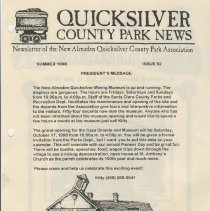
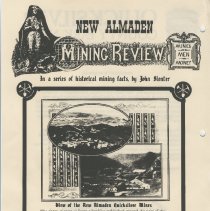
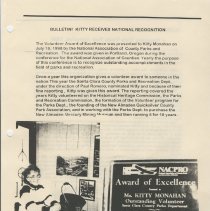
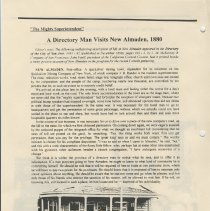
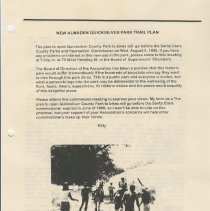
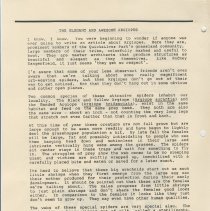
Additional Images [10]
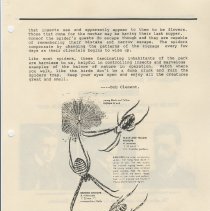
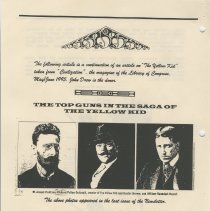
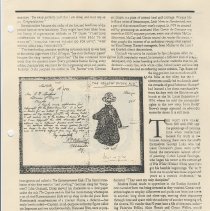
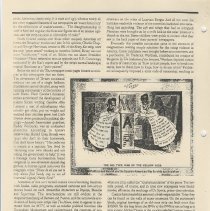
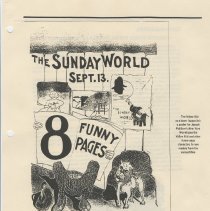
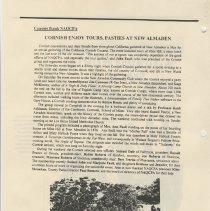
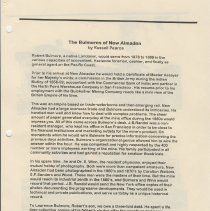
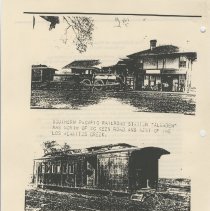
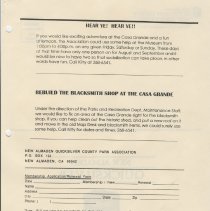
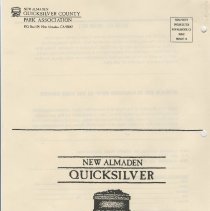
Metadata
Catalog number |
1997.2.2624 |
Object Name |
Newsletter |
Date |
1998 |
Description |
TITLE: Quicksilver County Park News SUBTITLE: Newsletter of the New Almaden Quicksilver County Park Association Issue # 52 SUMMER 1998 Newsletter of the New Almaden Quicksilver County Park Association SUMMER 1998 ISSUE 52 PRESIDENT'S MESSAGE The New Almaden Quicksilver Mining Museum is up and running. The displays are gorgeous. The hours are Fridays, Saturdays and Sundays from 10:00a.m. to 4:00p.m. Staff of the Santa Clara County Parks and Recreation Dept. facilitates the maintenance and opening of the site and the docents from the Association give tours and interpretive information to the visitors. Fifty-four docents now man the museum. Anyone who has not been informed about the museum opening and would like to spend a few hours a month at the museum just call Kitty. The grand opening for the Casa Grande and Museum will be Saturday, October 17, 1998 from 10:00a.m. to 4:00p.m. You will be given a formal invitation from the Parks Dept., but I want you to put this date on your calendar. This will coincide with our annual Pioneer Day and be great fun. There will be booths, speeches, food, wagon trips down through the village to see a mining demonstration, open house at St. Anthony's Church as the parish celebrates its 100th year and much more. Please come and help us celebrate this exciting event! Kitty (408) 268-6541 BULLETIN! KITTY RECEIVES NATIONAL RECOGNITION The Volunteer Award of Excellence was presented to Kitty Monahan on July 18, 1998 by the National Association of County Parks and Recreation. The award was given in Portland, Oregon during the conference for the National Association of Counties. Yearly the purpose of this conference is to recognize outstanding accomplishments in the field of parks and recreation. Once a year this organization gives a volunteer award to someone in the nation.This year the Santa Clara County Parks and Recreation Dept., under the direction of Paul Romero, nominated Kitty and because of their fine reporting , Kitty was given this award. The reporting covered the years Kitty volunteered on the Historical Heritage Commission, the Parks and Recreation Commission, the formation of the Volunteer program for the Parks Dept., the founding of the New Almaden Quicksilver County Park Association, and in working with the Parks Dept. to purchase the New Almaden Mercury Mining Museum and then running it for 18 years Superintendent" A Directory Man Visits New Almaden, 1880 Editor's note: The following unflattering description of life at New Almaden appeared to the Directory of the City of San Jose, 1881 - 83 (published in December 1880), pages 391 - 2, by L. M. A'fcKenney X ('ompany of San 1renrctsco. John Fault president of the California Cornish Cousins, had it printed beside a more positive account of New Almaden in the program. for the recent Cornish gathering. NEW ALMADEN. Post-office. A quicksilver mining town, dependent for its existence on the Quicksilver Mining Company of New York, of which company J. B. Randol is the resident superintendent. The mine, reduction works, road, store, hotel, stage line, telegraph office, church and town sites are owned by the corporation, and the people of the camp, numbering nearly one thousand, are controlled by the powers that be, to such an extent as to scarcely credit belief. We arrived at the place late in the evening, with a tired team and feeling rather the worse for a day's travel and hard work on the road. The only livery accommodations in the town are at the stage barn, where we were told that the "mighty superintendent" had forbidden the reception of strangers' teams, because two political stump speakers had stopped overnight, some time before, and advanced opinions that did not chime in with those of the superintendent. In the same way, it was necessary for the hotel man to go to headquarters and get the permission of some great personage, without which we actually could not have tarried in the place to eat and sleep, but would have had to turn around then and there and seek more hospitable quarters six miles distant. In the course of our business, it was necessary for us to drive over a piece of the new company's road, up the hill to the mine, for which we first obtained permission. On coming down again, we were eagerly assailed by the enslaved puppet of the telegraph office for what we thought an exorbitant toll (considering that no rates of toll are posted on the gate), he remarking, "Yes, this thing works both ways, first you get permission, then you pay for the privilege. The 'great king' says so and we must comply" The worthy minister.is chosen for his compliant disposition "I was so and so when I came to Almaden," he said, "but," and this with a wink characteristic of the funny little fellow, who, perhaps has at some other time entertained with his gyrations other audiences besides a church congregation, "I have undergone somewhat of a change." We think it is within the province of a directory man to notice what he sees, and to offer it as information. If a man purposes going to New Almaden, he ought to know to what kind of community he is committing himself He should be told that it will be required of him to trade at one particular store, where he will have to pay two prices for his purchases. He should know that it is expected of him to entertain only stated opinions about anything. He should be aware that he can not come and go when he pleases, and that only those of his friends who receive the sanction of his master, will be allowed to visit him. If he will, on knowing this, still located in such a place, let him locate and be - deprived of his individuality NEW ALMADEN QUICKSILVER PARK TRAIL PLAN The plan to open Quicksilver County Park to bikes will go before the Santa Clara County Parks and Recreation Commission on Wed. August 5, 1998. If you have any problems or interest in this new use in the park, please come to this meeting at 7:00p.m. at 70 West Hedding St. in the Board of Supervisors' Chambers. The Board of Directors of the Association has taken a position that this historic park would suffer tremendously if the hundreds of bicyclists who say they want to ride through this park do so. This is a public park and everyone is invited, but what a person brings into the park may be detrimental to the well-being of the flora, fauna, hikers, equestrians, its historic nature and the peace and tranquility of this delightful place. Please attend this commission meeting to express your views. My term as a The plan to open Quicksilver County Park to bikes will go before the Santa Clara commissioner expired in June of 1998, so I won't be able to vote on this proposal, but your support of your Association's concerns will help other commissioners make up their minds. Kitty THE ELEGANT AND AWESOME ARGIOPES I know. I know. You were beginning to wonder if anyone was ever going to write an article about Argiopes. Here they are, prominent members of the Quicksilver Park's grassland community, large members of their tribe, colorfully marked and useful to boot. They are master architects that produce structures as beautiful and elegant as they themselves. Like Rodney Dangerfield, it just seems 'they get no respect'. I'm aware that some of your less observant friends aren't even aware that we're talking about some really magnificent orb-weaving spiders, but then Argiopes don't go out of their way to get noticed. Not that they don't hang out in some obvious and rather open places. Two common species of these attracive spiders inhabit our locality. The Black and Yellow Argiope (Argiope aurantia) and the Banded Argiope (Argiope trifasciata), exist in the same habitat and feed on the same prey base. They both are also the same size - about an inch - not counting the very long legs that stretch out even farther than that in front and back. At this time of year these creature are not full grown but are large enough to be seen more readily and have begun to lightly dent the grasshopper population a bit. By late fall the females will be large, fat and possibly intimidating to people who see them hanging head down and motionless in their large and intricate vertically hung webs among the grasses. The spiders sit center stage in these traps and wait for something to fly in. The struggles of prey show the web owner to be no sleeping giant and victims are swiftly wrapped up, immobilized with a carefully placed bite and eaten or saved for a later snack. Its hard to believe that these big arachnids start out as such little shrimps when they first emerge from the large egg sac their mother produced for their protection during their early development. It should be pointed out that these are the females we're talking about. The males progress from little shrimps to just plain shrimps and don't share the females good looks either. In comparison to the females it looks like they just don't seem to grow up. They may even have other human qualities. The webs of these special spiders are very special also. The center has a heavy zigzag mat of silk, called a stabilimenta, where the hungry occupant waits. Once thought to be for strength, to camouflage the owner or to protect the spider from too much sun, experiments appear to show that it is probably just to makeit visible to small birds when the spider is on a break. These webs are very large and require enormous energy to produce. Errant birds wreak havoc on those that are not easily seen. Like most things in nature, thats not quite all of the story. Central American Argiopes have these zigzag patterns all over their webs. These zigzag areas reflect wave lengths of light that insects see and apparently appear to them to be flowers. Those that come for the nectar may be having their last supper. Someof the spider's guests do escape though and they are capable of remembering their mistake and narrow escape. The spiders compensate by changing the patterns of the zigzags every few days as their clientele begins to wise up. Like most spiders, these fascinating inhabitants of the park are harmless to us, helpful in controlling insects and marvelous examples of the balnce of nature in operation. Watch where you walk, like the birds don't be a dumb cluck and ruin the spiders trap. Keep your eyes open and enjoy all the creatures great and small. ----Bob Clement. sue! , MA. \ l (BANDED ARGIOPE A. trifosciato e . Joseph Pulitzer; Richard Felton Outcault, creator of the Yellow Kid and Buster Brown; and William Randolph Hearst Almost every paper acquired a yellow tint. Even high-minded owners allowed their editors to take the low road. One. week. when Pulitzer staved home, hoping to restore his failing vision, ha-telegraphed his managing editor: "Please have on the font page of the wager: tue In next Sunday's World. the fine portrait or General 0.0 Ho;:,u-d, head of the Army." Several days later the editor wired-hick: "Sorry we did not have that 0.0. Howard picture. Instead, of" the rrow pare, 1 had a wonderful picture of Kate Swan in the electric chair and circulation is up 15,000." Pulitzer was magnanimous in response: "You know perfectly :ell that l am blind, and must rely on you. Congratulations.'' Sensationalism became the order of the day, and headlines of the period have an eerie familiarity. They might have been taken from the lineup of supermarket tabloids or TV Guide: "STARTLING CONFESSION OF WHOLESALE MURDERER WHO BEGS TO BE HANGED"; "STRANGE THINGS WOMEN DO FOR LOVE"; "WHY tru h than the speakers knew. Every printable human failing, every ethnic characteristic was meat for the burgeoning strips and panels. Rudolph Dirks peopled his comic in The journal with German immigrants and called it The Katzenjammer Kids. (The literal translation of the first word is "cats' yowling," German slang for "hang-over") Like Outcault, Dirks moved his characters to a rival paper under the tite The Captain and the Kids for more money, whereupon a set of rival Katzenjammer Kids set up shop in the old place. Both Plattdeutsch misadventures of a tolerant Mama, a choleric-but easily bamboozled-Captain, an all-purpose authority figure called the Inspector, and two mischievous kids, Hans and Fritz, were so popular that they continued concurrently for some 60 years. Frederick Opper also came up with a pair of strips: Happy Hooligan, whose last name was synonymous with troublemaker, and Alphonse and Gaston, two pathologically courteous Frenchmen whose dialogue has lived on in the American lexicon. ('After you, my dear Alphonse." "No, after you, my dear Gaston:') George McManus found rich material in his own background, satirizing an arriviste Irish couple. The embattled pair have entered our folklore: Maggie, who wants to join society, and Jiggs, whose fond? 9 THE NEXT FEW YEARS from 1910 until 1919, wQ5' the golden age of comics,a time when intellectuals looked for truth in rha funnies. Among them were the artis s themselves: George Luks, who had taken Outcault's place, went on+O found the naturalistic Ashcan schcol of painting. Cubist Lyonel Feinings, who began his career as the cartoons+ of Wee Willie Winkie's World, never tot.... got his humble beginnings. "Far be it from me to underrate those importar>f years as a comics draftsman," he. declared. "They were my only discipline." Readers found much to appreciate in the Sunday funnies.A new narrative form was being invented as they watched. Comic-str p artists began to employ silhouettes and quick cuts from one scene to another, long shots and close-ups, moving their characters through time and space with the audacity of another emerging at the cinema. No wonder that SO years later a file of directors, including Federico Fellini, Alain Renais and Orson Welles, would acknowledge their debt to the strips they read in childhood. Examining the words inside the balloons, H.L. Mencken commented that the newspaper artist had "been a very diligent maker of terse and dramatic words ... e.g. zowie, barn, socko, yurp, plop, wow, wain, glug, oof, ulk, whap, bing, flooie and grr. Their influence ... upon the general American vocabulary must be very potent, and no doubt they also have some influence upon American ways of thinking:' Other intellectuals chimed in, some with peculiar opinions about comics. Social historian Gilbert Seldes praised the "hardness or the American comic strip. It is male and ugly, whereas nearly all the other magazine features of our newspapers are `sweet femininity' for the delectation of washerwomen.... The draughtsmanship in itself:s hard and angular; the faces and figures are of an intense ugliness. and the strip rejoices in a brutality of color." Seldes favored comics over those other uniquely American art terms, the Broadway musical and jazz. In his opinion, Charlie Chap-in-. and George Herrunan, creator in 1911 of the Krazy Kat strip, were the only "great artists" working in America. Indeed, Krazy was our most "satisfactory" work of art. Seldes was not alone. President Woodrow Wilson refused to miss an episode; and E. E. Cummings, enchanted by the Kat's capers and by the strip's surreal landscape, praised Herrman as a "poet-painter!' Before the end of the '20s, newspaper comic pages became as complex as the newspapers that ran them. The adventures of Tartan continued without the use of a single balloon; illustrations carried the plot, along with running commentary at the bottom of each frame. Flash Gordon's futuristic stories accelerated the development of science fiction writing. Gasoline Alley featured a cast of suburbanites who actually got older, put on weight and watched their children grow. And Little Orphan Annie promoted a political ideology-Annie's benevolent guardian, Daddy Warbucks, was an unabashed plutocrat. According to Annie's artist/writer, Harold Gray, liberals were " guvs who don't do their homework, trey don't know history." His credo was as simple as a caption: You lived by "skinning your own skunks and not asking the government to help." It was a message many businessmen found congenial. In one adventure Annie's dog got lost. A distress signal came over the telegraph wires: "Please do all you can to help Annie find Sandy stop we are all interested (signed) Henry Ford." Attention of this sort turned comics into a booming business, with books, radio programs, animated cartoons and live-action movies based on such irresistible characters as Popeye, Blondie and Superman. The reverberations are still evident in the megarnerchandising of Barman and Peanuts, and the nationwide syndication of funky new strips like The Maxx, soon to appear in animated form on MTV, as well as reliable political favorites like Doonesbury. Mainstream and underground, the creatures of yestcrday's and today's comics have all rumbled from the Kid's shirt. But the Yellow Kid also left a dubious legacy. From his earliest work, Outcault displayed racist tendencies: In The Yellow Kid's Great Fight," the hero hit his little black opponent so hard that he suffered a dislocated jaw In the penultimate panel, the boy lies supine, while a billy goat munches on the "wool" on his head. Villains in the adventure series were generally portrayed as swarthy southern Europeans or "natives," the term applied to Africans and Asians. Many women were underdressed victims or 10 schemers on the order of Lucrezia Borgia. And all too soon the harmless vaudeville violence of the comedies hardened into some-thing less appealing. The oofs and whops that had so intrigued Mencken were brought on by a swift kick in the solar plexus or a thumb in the eye. Some children were quick to imitate what they saw in the back pages of their parents' newspapers. Eventually this possible connection came to the attention of congressmen seeking simple solutions for the rising violence in merica. Comic publishers were brought before subcommittees, and a psychiatrist, Dr. Frederick Wertham, contributed his critique of the genre. In The Seduction of the Innocent, Wertham depicted comics as charts of instruction on "how to hurt people, how to break into stores, how to cheat, how to forge, how to do any crime." Publishers subsequently imposed a strict code of censorship, resulting in what one critic called the "total emasculation" of the genre. The hysteria passed, of course, and in time new scapegoats were found: movies, affluence, the teachings of Dr. Spock, prime-time television. Comics have meanwhile assumed a fresh respectability. Today they can be found on the walls of major museums. On the auctioneer's block, original drawings of an old-time strip can fetch more than $20,000. Yet the leap from the 1890s to the 1990s is not as long as it may appear. Mickey Dugan is the unacknowledged patron sinner of The Star and The Enquirer (CHEATING WIFE'S HEAD EXPLODES! GINGRICH TALKS TO EXTRATERRESTRIALS!). His long shadow falls across Oprah, A Current Affair and Geraldo. The claims of comic art are loud and legitimate. But the combined efforts of revisionist col-lectors, critics and artists have never erased the genre's checkered past. A good thing, too. For it is fair to salute the beauty and humor that comics have given us. And fairer still, at a time when O.J. and Princess Di claim the front-page headlines, to remember that the Kid wasn't named for yellow journalism. It was named for him. Cousins thank NAQCPA CORNISH ENJOY TOURS, PASTIES AT NEW ALMADEN Cornish descendants and their friends from throughout California gathered at New Almaden in May for an annual gathering of the California Cornish Cousins. The event included tours of Mine Hill, a pasty lunch and the last tour of the old museum. "The success of our program was completely dependent on the good efforts of NAQCPA, and especially the tour guides," said John Faull, who was president of the Cornish group and organized the event. The three-day event began on a Friday night when Cornish Cousins gathered for a social evening at a nearby hotel and shared stories about their families, the old country of Cornwall, and life in New World mining camps like New Almaden. It was a highlight of the gathering. On Saturday the event moved to the New Almaden Community Club where the cousins enjoyed a pasty lunch and heard talks by Assemblyman Jim Cunneen (R-San Jose), a New Almaden descendant, and Gage McKinney, author of A High & Holy Place: A Miring Camp Church at New Almaden, About 100 made the trek up the hill to the site of English Camp (also known as Cornish Camp), where more than 1,000 Cornish men, women and children made their homes over the course of the late nineteenth century. The afternoon included walking tours of the Hacienda, a demonstration of Family Tree Maker software in the Opry House, a Cornish cooking demonstration by Robyn Houts, and plenty of socializing. The group moved to Campbell in the evening for a barbecue dinner and a talk by Professor Keith Atkinson, Director of the Camborne, Cornwall, School of Mines. They also heard Russell Pearce, a New Almaden descendant, speak on the history of the Cornish pump, the steam-driven device that drained the water from mines, including the New Almaden mine. The weekend concluded with worship on Sunday morning at the Los Gatos United Methodist Church. The printed program included a photograph of Mrs. Ann Faull standing on the porch of her boarding house on Mine Hill at New Almaden in 1876. Ann Faull was the "Mother Fall" who was a favorite of Arthur and Mary Hallock Foote when they lived on the hill. She was described in Mary Hallock Foote's memoir, A Victorian Gentlewoman in the Far West, and consequently in Wallace Stegner's Pulitzer Prize-winning novel, The Angle of Repose. The program also included the words and music to "Trelawny," the Cornish anthem, which was sung on Saturday night. During the weekend the Cornish selected new officers: Samuel Dale of Fallbrook, president; Russell Pearce of Orinda, president-elect; Robin Roberts of Hanford, secretary; Joe Roberts of Stockton, treasurer; Maureen Roberts of Stockton, membership chair; Bert Trerise of Plancentia, newsletter editor The membership warmly thanked John and Marjorie Faull, and daughters Brittany and Jennifer, for their countless hours of work in organizing the successful event. John in turn thanked NAQCPA president Kitty Monahan, County Parks Director Paul Romero, and the board of directors of NAQCPA for their help. The Bulmores of New Almaden by Russell Pearce Robert Bulmore, a native Londoner, would serve from 1878 to 1899 in the various capacities of accountant, Hacienda foreman, cashier, and finally as general agent on the Pacific Coast. Prior to his arrival at New Almaden he would hold a Certificate of Master Assayer for her Majesty's mints; a commission in the British Army during the Indian Mutiny of 1856-59; accountant with the Commercial Bank of India; and partner in the North Point Warehouse Company in San Francisco . His resume prior to his employment with the Quicksilver Mining Company reads like a mini view of the British Empire of his time. This was an empire based on trade-waterborne and then emerging rail. New Almaden had a large overseas trade and Bulmore understood its intricacies. He handled men well and knew how to deal with complex problems. The sheer amount of paper generated everyday at the mine office during the 1880s would impress you. All of this came across Bulmore's desk. J.B.Randol was a non-resident manager, who kept his office in San Francisco in order to be close to the financial institutions and marketing outlets for the mine's product. On momemnts whim he would wire Bulmore for precise information concerning the previous days activities. Bulmore's organizational genius allowed him to wire the answer within the hour. He was competent and highly respected by the 400 number or more imployees working at the mine. His family participated in all community activities and had gained a reputation for amatuer theatricals. In his spare time , he and Dr. S. Winn, the resident physician, enjoyed their mutual hobby of photography. Both were more than competent amateurs. New Almaden had been photographed in the 1860's and 1870's by Caralton Watkins, S.P.Sanders and Wood. These men were the masters of their time. But the mine would reach its industrial zenith in the 1880's, and Bulmore and Winn would record that period. J.B. Randol would send the New York office copies of their photos documenting the progressive developments. They would be used in technical and private publications, and serve us today as a unique historical record. To Laurence Bulmore, Robert's son, we owe a three-fold debt. He spent a life time collecting copies of his father's photos after the negatives had been carelessly destroyed. He was one of the three founders of the New Almaden Historical Society, and he managed in his 84 years to write and publish the results of his labor. With his lovely wife, Martha, he was a real force in preserving Santa Clara County's history. Active in politics and the church, a marine engineer by profession, his life was not solely absorbed by the past. He knew that New Almaden's role in history was secure. HEAR YE! HEAR YE!! If you would like exciting adventure at the Casa Grande and a fun afternoon, the Association could use some help at the Museum from 1:OOpm to 4:00p.m. on any given Friday, Saturday or Sunday. These days at that time have only one person on for August and September and it would be nice to have two so that socialization can take place, in other words have fun. Call Kitty at 268-6541. REBUILD THE BLACKSMITH SHOP AT THE CASA GRANDE Under the direction of the Parks and Recreation Dept. Maintenance Staff, we would like to fix an area at the Casa Grande sight for the blacksmith shop. If you can help clean out the historic shed, and put a new roof on it and move in the old Map Desk and blacksmith items, we could surely use some help. Call Kitty for dates and times. 268-6541. NEW ALMADEN QUICKSILVER COUNTY PARK ASSOCIATION P.O. BOX 124 NEW ALMADEN, CA 95042 |
People |
Monahan, Kitty Slenter, John Clement, Bob Faull, John Cunneen, Jim Pearce, Russell |
Cataloged by |
Meyer, Bob |
